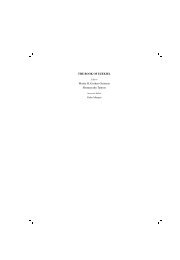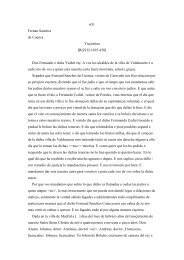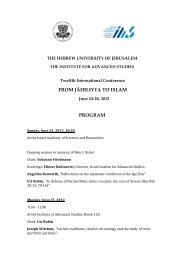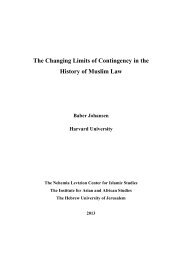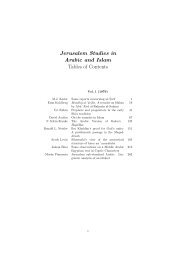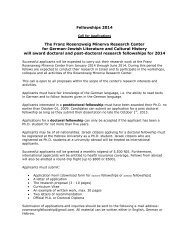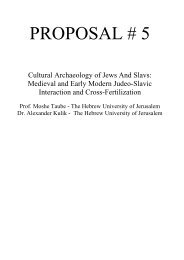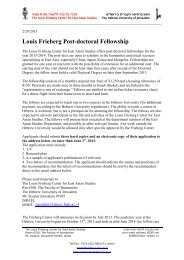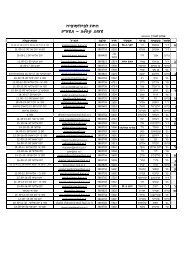Proverbs 7 in MT and LXX: Form and Content
Proverbs 7 in MT and LXX: Form and Content
Proverbs 7 in MT and LXX: Form and Content
You also want an ePaper? Increase the reach of your titles
YUMPU automatically turns print PDFs into web optimized ePapers that Google loves.
<strong>Proverbs</strong> 7 <strong>MT</strong> <strong>and</strong> <strong>LXX</strong> 145<br />
ancient culture <strong>and</strong> art; 36 it has been <strong>in</strong>terpreted <strong>in</strong> reference to temple<br />
prostitution <strong>and</strong> w<strong>in</strong>dow-goddesses, from Mesopotamian Kilili to<br />
Aphrodite Parakyptusa. 37 Tempt<strong>in</strong>g as it may be, the woman look<strong>in</strong>g<br />
through the w<strong>in</strong>dow <strong>in</strong> our scene is neither a goddess nor a cult prostitute.<br />
While the translator was probably <strong>in</strong>fluenced by this common motif <strong>and</strong><br />
rewrote our scene accord<strong>in</strong>gly, he did not import the cultic sett<strong>in</strong>g <strong>in</strong> any<br />
visible form. 38<br />
The translator’s misconstruction becomes apparent <strong>in</strong> v. 10, that <strong>in</strong> the <strong>MT</strong><br />
beg<strong>in</strong>s the second part of the argument: after describ<strong>in</strong>g the lad stroll<strong>in</strong>g<br />
through the market, a woman appears on the scene, <strong>in</strong>troduced with <br />
“<strong>and</strong> behold...”. The author is about to elaborate at length on the character<br />
<strong>and</strong> behavior of this woman. Her general type was mentioned <strong>in</strong> v. 5. Now,<br />
<strong>in</strong> vv. 10ff, a specific woman of this sort comes forward. No wonder that <strong>in</strong><br />
the <strong>LXX</strong> v. 10 does not offer a counterpart for , beg<strong>in</strong>n<strong>in</strong>g <strong>in</strong>stead with <br />
... “<strong>and</strong> the woman...,” that is, the same woman that was the<br />
subject of the former verse.<br />
The difference between the <strong>LXX</strong> <strong>and</strong> the <strong>MT</strong> extends beyond the change of<br />
scene. The translator seems to take the liberty of rewrit<strong>in</strong>g his Vorlage <strong>in</strong><br />
ways that are unlikely to have happened <strong>in</strong> a Hebrew text. His <strong>in</strong>terference<br />
36 See C.E. Suter, “Die Frau am Fenster <strong>in</strong> der orientalischen Elfenbe<strong>in</strong>-<br />
Schnitzkunst des frühen i. Jahrtausends v. Chr.,” Jahrbuch der Staatlichen<br />
Kunstsammlungen <strong>in</strong> Baden-Württemberg (München, 1992) 7–28.<br />
37 While the very same verb— —is used, it is not necessarily drawn<br />
from the Greek cultural imagery. It is, after all, the most appropriate verb for the<br />
context <strong>and</strong> is used <strong>in</strong> scenes which have noth<strong>in</strong>g to do with w<strong>in</strong>dow-goddesses,<br />
cult prostitutes or women <strong>in</strong> general. Thus, “Abimelech k<strong>in</strong>g of the Philist<strong>in</strong>es,<br />
look<strong>in</strong>g out of the w<strong>in</strong>dow...” is, <strong>in</strong> the <strong>LXX</strong>, / <br />
0 ( (Gen 26:8).<br />
38 The <strong>in</strong>terpretation of the seduction scene of Prov 7 as represent<strong>in</strong>g a scene of<br />
sacral prostitution is primarily associated with G. Boström, Proverbiastudien: die<br />
Weisheit und das fremde Weib <strong>in</strong> Spr. 1–9 (LUÅ 30; Lund, 1935) 103–155, 173. He has<br />
been criticized by McKane, <strong>Proverbs</strong>, 334–336; Fox, <strong>Proverbs</strong>, 134–141, 231–233,<br />
252–258.



